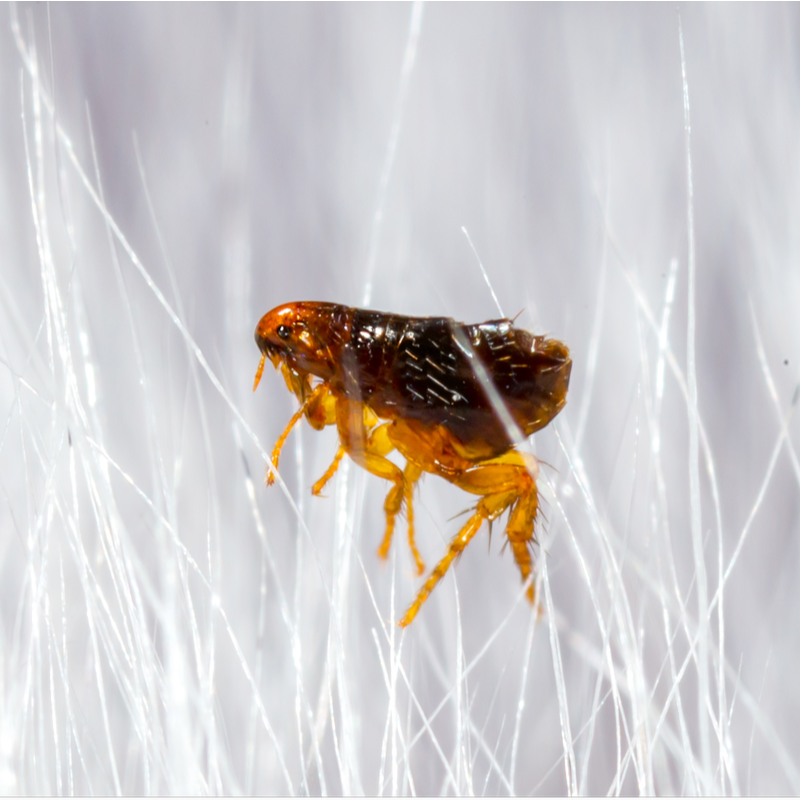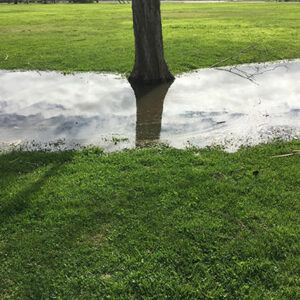Is Aeration and Overseeding Right for Your Eastern PA Lawn?
Here in South Eastern PA, summer can be rough on our landscapes. With our fluctuating temperatures and unpredictable weather patterns, both summer heat and excessive flooding can damage our lawns. Add to that the playtime, lawn equipment, and vehicles we often drive on our grounds; this can all take a significant toll on our grass. Many times these stressors can compact our soil and produce excessive thatch. Fortunately, there is a solution. Lawn aeration is a service that will help to revitalize your lawn. Read on and learn everything there is to know about compacted soil, aeration, and a process called overseeding that can also increase the health of your lawn.What Is Compacted Soil?
- Spongy grass
- Water runs off or pools in areas of your yard.
- Bare or patchy areas of grass
- Stunted growth of plants
- Hard soil
What Is Thatch?
Thatch is an intermingled blend of organic material that gathers between the soil and the grass. As it builds up, it too prevents essential elements such as water, air, and nutrients from penetrating your soil. When these elements are unable to get to your roots, your grass will begin to weaken, wither and eventually die. Soil compaction and thatch are two of the biggest lawn problems that residences and businesses in Eastern Pennsylvania face.Aeration to the Rescue
A process called lawn aeration can help relieve your grass of soil compaction and excessive thatch. It is the process of removing plugs of soil from your grass, depositing them on top, and distributing them across your lawn.Additional Benefits of Lawn Aeration Include:
- Reduces compacted soil: Cores of compacted soil are pulled from the lawn, allowing grassroots to spread out and grow deeper.
- Reduces excess thatch: Aeration relieves your lawn of excess thatch, allowing your grass easy access to air, water, and nutrients.
- Access to water, air, and nutrients: Relieving soil compaction and reducing thatch build-up enables your grass to have easier access to air, water, and fertilizer.
- Stronger root system: With less soil compaction, your grassroots will have more space to spread out. This results in deeper root systems and healthier grass.
When Is the Best Time To Aerate Your Lawn?
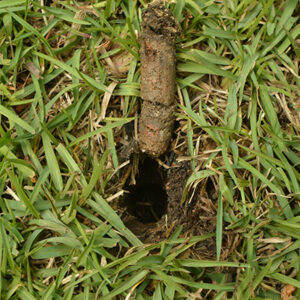 Able to be performed annually, lawn aeration should only ever be performed during the growing season. Here in Pennsylvania, most of our lawns are made of cool-season grasses such as tall fescue, Kentucky bluegrass, and ryegrass. The growing season for cool-season grasses is in the spring and fall. Having aeration performed now in the fall will help to strengthen your roots and prepare them for our upcoming frigid winters.
Able to be performed annually, lawn aeration should only ever be performed during the growing season. Here in Pennsylvania, most of our lawns are made of cool-season grasses such as tall fescue, Kentucky bluegrass, and ryegrass. The growing season for cool-season grasses is in the spring and fall. Having aeration performed now in the fall will help to strengthen your roots and prepare them for our upcoming frigid winters.
Overseeding Your Eastern PA Lawn
Typically done after aeration, overseeding is the application of new grass seeds onto your existing yard. Usually, it is a mix of different strains of grass. Adding in a variety of grasses can help increase your turf's resistance to lawn pests, drought, and lawn disease. Overseeding can also quickly thicken up your lawn and fill in bare spots.How to Prepare Your Lawn Before Aeration and Overseeding Services
Fall is the best time for lawn aeration, but it’s essential to prepare your lawn for the service. Make sure to mark any areas near electric dog fences and mark your sprinkler heads as well. This helps your lawn care technicians navigate your lawn safely, without causing any accidental damage. It’s also a good idea to make sure the soil is moist before your aeration service. Watering your grass a couple of days before the service will ensure the tines from the aerator can easily penetrate the soil.Contact the Professionals at Showcase Lawn Works for Professional Aeration and Overseeding Services Now
Revitalize your lawn with Showcase Lawn Work's aeration service. Or combine it with our overseeding service and bolster the strength of your grass, making it less prone to pest infestations, disease, and weeds. Learn more about our aeration and overseeding services by reaching out to us online or calling us at 717-354-3226. Invest in our year-round lawn care program now and start giving your turf the care and nutrients it needs when it needs them. Discover more tips and ideas through our monthly blog articles. Then check us out on social media and like us on Facebook. We can't wait to work with you. Request A Quote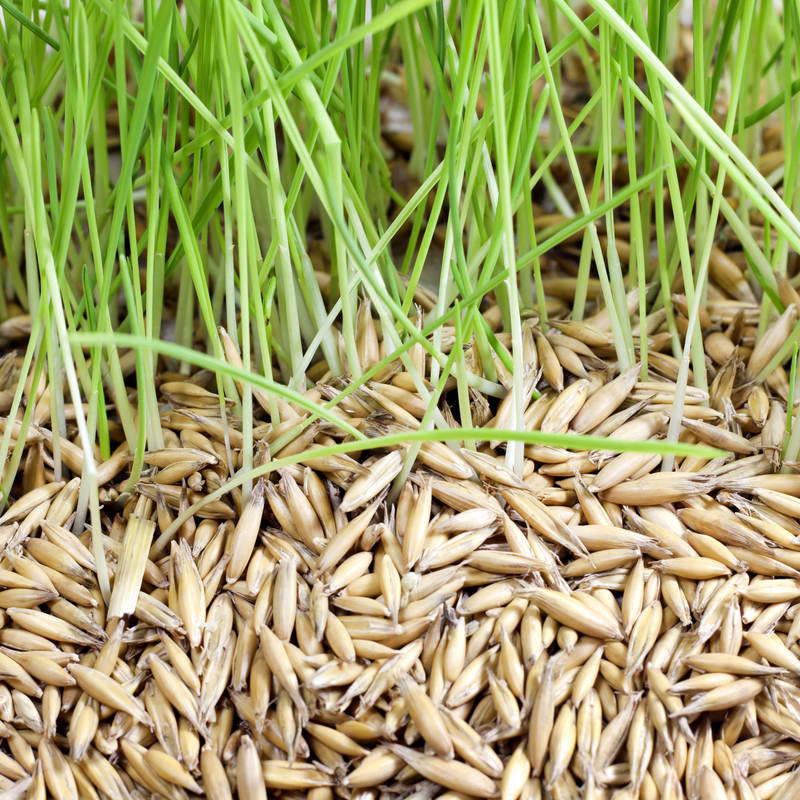
Five Ideas to Extend Your PA Gardening Season Well Into the Fall
As fall slowly starts to move in here in Lancaster and the days get shorter and the nights get colder, you probably think your days of gardening are numbered. But avid gardeners know that is not the case. Cooler temperatures are actually easier on plants, while the soil is still warm enough to allow roots to grow until the ground freezes. Below the ground level, roots are growing, microbes and earthworms are doing their work, and things are still biologically alive. While there is typically more rainfall during autumn, the more moderate temperatures mean it's easier to keep your plants hydrated, and pests are starting to retreat and get ready for hibernation. If that isn't enough to convince you, check out the bargain deals you can get on plants at garden centers trying to get rid of inventory before winter. Look for deals on spring-blooming bulbs, perennials, and trees and shrubs. So, what are the best type of plants to seed this time of year? Showcase Lawn Works has the answers. Here are five plants you can and should be planting this fall for optimal growth.Bulbs
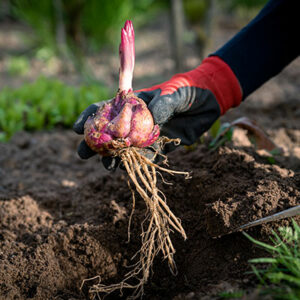 As long as your soil temperatures are still above 50 degrees, fall makes the perfect time to plant bulbs for flowers that bloom in spring and summer. Many bulbs come in a wide variety of colors, heights, and bloom times, so you can determine what works best in your garden. Some of the most common include tulips, daffodils, alliums, crocus, and lilies. If rabbits or deer are a problem, they don't like plant bulbs such as daffodils, hyacinths, and alliums.
To make sure bulbs perform well, plant them where they will receive plenty of sun. Most bulbs should be planted two to three times as deep as the diameter of the bulb. Place the bulb in the hole pointy side up. Leave the foliage in place until it dies so the bulb can use it as food for next spring's blooms.
As long as your soil temperatures are still above 50 degrees, fall makes the perfect time to plant bulbs for flowers that bloom in spring and summer. Many bulbs come in a wide variety of colors, heights, and bloom times, so you can determine what works best in your garden. Some of the most common include tulips, daffodils, alliums, crocus, and lilies. If rabbits or deer are a problem, they don't like plant bulbs such as daffodils, hyacinths, and alliums.
To make sure bulbs perform well, plant them where they will receive plenty of sun. Most bulbs should be planted two to three times as deep as the diameter of the bulb. Place the bulb in the hole pointy side up. Leave the foliage in place until it dies so the bulb can use it as food for next spring's blooms.
Pansies and Violets
Fall is an excellent time to plant pansies and violets because the soil is still warm enough to give their roots time to grow. They are one of the five most frost-resistant and cold-tolerant flowers. Plus, planting in the fall will allow you to get more overall bloom time because they will begin to fade out in the summer when the temperatures get too hot. Pansies planted in August or September will bloom and last throughout winter and spring. Flowering usually starts in early March. To help them overwinter, add a thick layer of mulch around them once your ground has frozen. Though they prefer the sun, they will grow in partial shade.Vegetables
Just because it's fall doesn't mean growing vegetables is over. If you begin now through September, you can extend your harvest season well into late fall, maybe even winter. A few of the best vegetables to grow in the fall include beets, carrots, onions, broccoli, asparagus, salad greens, and garlic. The hardiest fall vegetables are spinach and kale, which can grow into winter. When it comes to growing veggies in the fall, you'll want to start by using seeds. Plant them a little deeper than you would in the spring, and be sure to keep them well-watered, about an inch of water per week. You can extend your growing season later in the fall by covering your garden with an old sheet or blanket if frost is in the forecast. If done correctly, you can have fresh veggies from your own garden added to your dinner table this Thanksgiving!Cool-Season Grasses
Cool-season grasses such as Kentucky bluegrass, perennial ryegrass, fescue, and bentgrass thrive in the fall, whether you're planting seed or sod. In fact, fall is the best time to plant cool-season grasses. The combination of cool evenings, moderate temperatures, and warm sun enable the seeds to germinate faster, providing you with a rich, fuller lawn. There are also fewer weeds for the seeds to compete with during the fall, giving them a better chance of survival. Showcase Lawn Works offers both seeding and sod installation services to help you get the beautiful grass you desire.Trees and Shrubs
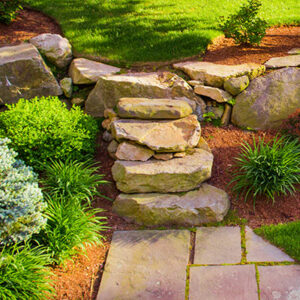 Roots can grow in soil as cold as 40 degrees, and soil remains warm long after the air temperature drops. In Lancaster and the surrounding areas, roots can usually grow through December, but you need to plant trees and shrubs six to eight weeks before then, which means now through October. A few trees and shrubs that make for great growth in the fall include:
Roots can grow in soil as cold as 40 degrees, and soil remains warm long after the air temperature drops. In Lancaster and the surrounding areas, roots can usually grow through December, but you need to plant trees and shrubs six to eight weeks before then, which means now through October. A few trees and shrubs that make for great growth in the fall include:
- Knock Out Roses
- Laurel
- Burning Bush
- Forsythia
- Hydrangea
- Elderberry
- Alder
- Ash
- Buckeye
- Catalpa
- Hawthorn
- Honey Locust
- Linden
- Maple
- Sycamore
For All Your Landscaping and Lawn Care Needs, Call on the Professionals at Showcase Lawn Works
Need help with your landscaping? Call on the professionals at Showcase Lawn Works. Serving Lancaster, Chester, and Berks Counties, Showcase Lawn Works specializes in lawn care, tree and shrub care, pest control, and landscaping. Our landscape design team can help you determine which plants and ornamentals work best for you and then handle the design, layout, and planting. We also offer a high-quality tree and shrub care program to help you with the ongoing maintenance of these beloved plants. Our tree and shrub care program consists of six visits, offering fertilization, insect, and disease control throughout the growing season. As a secondary option, we offer deep-root fertilization, dormant oil applications, and winter burn treatments. Learn more about these programs by visiting our website, requesting a free estimate online, or giving us a call at 717-354-3226. We can't wait to hear from you. Did you enjoy the tips we shared above? Great! Check out our other blog articles and stay tuned for next month's informative piece. And don't forget to check us out on Facebook. Request A Quote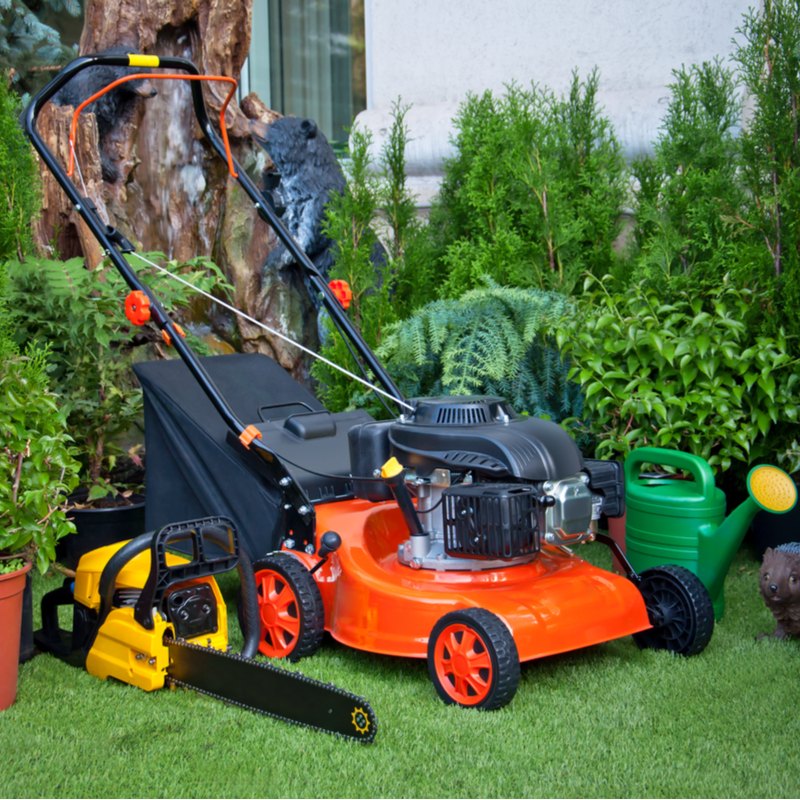
Top Five Landscaping Trends in South Central PA for 2021
2020 was a huge year for the landscaping industry. Being stuck inside and at home during the COVID pandemic gave everyone around the country and here in South Central PA a new perspective on their surroundings and new forms of entertainment. Many of us started new hobbies such as crafting and gardening while others created staycations in our own backyards. We created office spaces in our living rooms, classrooms in our kitchens and made our outside spaces into extensions of our homes. Many of these trends continue to exist through 2021, bringing the outdoors inside and the inside to the outdoors. Here is a list of this year's five hottest landscaping trends to get you motivated and started on your own property.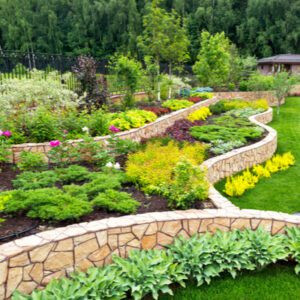
Gardening
Gardening was listed as one of the top new hobbies picked during the pandemic, with new gardeners joining more seasoned gardeners in everything from growing our own food to planting flowers, trees, and shrubs. Over 20 million new gardeners joined this hobby in 2020, and this trend has not waivered. This year, gardeners are adding easy-to-grow flowers such as sunflowers, marigolds, impatiens, and snapdragons. According to Better Homes and Gardens, bold, bright, tropical plants are also a big trend livening the mood and brightening homes everywhere. Other gardening trends include growing your own edibles in small spaces. Last year, everyone was developing their own vegetables. An increase in home cooking and concern regarding food scarcity caused more people to start their own kitchen gardens. This year, people realize you don't have to have a lot of space to do so. You can make use of small spaces by growing herbs and vegetables vertically, through the use of vertical gardening (which we talk about more later,) and within existing ornamental beds and borders.Vertical Gardening
As mentioned above, this involves growing plants on vertically suspended panels either freestanding or attached to a wall. Through the use of hydroponics, it provides the pop of color a small apartment, condo, or house needs and allows one to grow plants and vegetables when confined to small spaces. Another trend in vertical gardening is green walls. Some are walls covered with climbing plants while others involve a panel that allows plants to grow inside.Creating Outdoor Living Spaces
In an effort to bring the indoors outside, many people are creating extra space by utilizing their outdoor areas. The addition of living rooms, play areas, and kitchens outside have become a popular trend in the last year. Here in South Central PA, where we experience cold winters, we are seeing an uptake in the installation of outdoor heaters, overhead awnings, firepits, screened-in porches, and pergolas to help extend the outdoor season.Outdoor Firepits
Now a necessity for your landscape is the outdoor firepit. Not only is a firepit great at whipping together mouthwatering s'mores, but a backyard firepit provides a central point for entertaining and camaraderie. Nowadays firepits come in all shapes, sizes, and styles and can be customized to fit the unique personality of your family. And like the outdoor living room, fire pits offer an extended outdoor season for our South Central PA cooler falls and colder winters.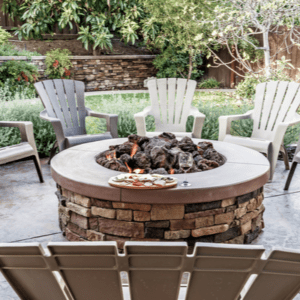
Pollinator Gardens
More and more people are becoming aware of the role pollinators play in society and are deciding to use plants that attract pollinators and changing their outdoor spaces into native habitats. More homes are utilizing birdfeeders, bat houses, and butterfly shelters to help attract pollinators to their yard. Tired of mowing your lawn and hand-pulling those weeds? The latest trend is to forego the clean, well-manicured look for a more natural feel, including planting in clumps rather than in single plants and using plants native to the South Central PA area. Of course, check with your local township, or association first to ensure there aren't rules against this kind of landscape.For All Your Landscaping Needs, Call Showcase Lawn Works
Now that we’ve described the five hottest new landscaping trends for you, allow Showcase Lawn Works to help upgrade your South Central PA area landscape. Showcase Lawn Works specializes in custom landscape design. We partner with you directly and offer customized, personalized solutions. We can help you with your gardening, planting, pruning, and trimming of trees, installing shrubs and plants for pollinators, vertical gardening, and more. Just give us a call at 717-354-3226 or contact us here to learn more. We also offer a highly effective lawn care program, tree and shrub care, pest control, flea & tick control, mosquito control, aeration and overseeding, debris clean up, mowing, and a variety of other services. Learn more or contact us now. Find this article helpful? Share with your family and friends and then check out our other blog articles for more awesome tips and ideas. Don't forget to visit us on Facebook! Request A Quote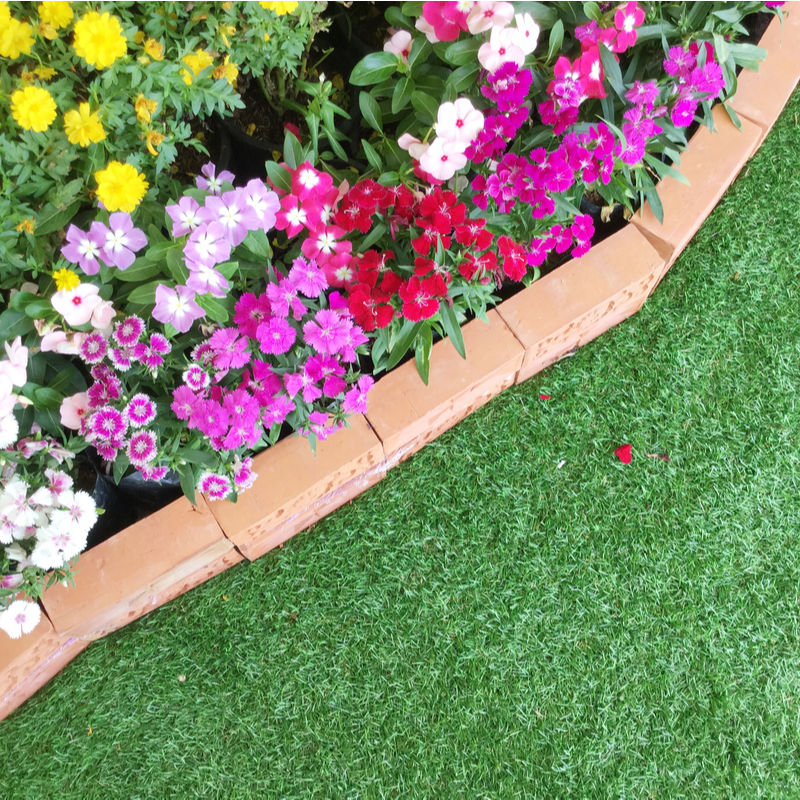
Create a Privacy Wall Around Your PA Lawn With 1 of These 5 Evergreens
We have plenty of trees in Pennsylvania. With our abundance of mountains, our state is canvassed with lush, green foliage. They create oxygen, provide shade, and offer food and shelter to various wildlife, birds, and insects. One benefit you may not have thought about is that they also create a perfect privacy wall. Utilizing trees for a privacy fence is a low-cost, easy way to put up a barrier between your house and the sometimes nosy neighbors. A line of emerald green beauty, this privacy wall will also help block out sounds from traffic, lawn equipment, noisy kids, and barking dogs. Interested, but not sure which trees make the best privacy wall? Never fear, Showcase Lawn Works has created a list of the five top evergreens for your home or business's privacy wall.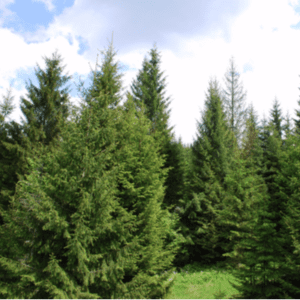
Norway Spruce
If you're looking to create a privacy wall fast, the Norway spruce is not only a faster-growing evergreen but the fastest growing of the spruce family. It is a popular choice for privacy fences and windbreakers. With a pyramid shape at the top, it can grow to heights of 100 feet and live for centuries. It prefers full sun and well-drained soil. It is an easy tree to take care of and competes well with grass and weeds. Pest resistant, this evergreen hardly ever falls victim to insects or disease, making it a perfect choice for both homes and businesses. It is also quite resistant to deer. Could this be the ideal tree for a privacy fence? I think we have a winner here.Douglas Fir
This soft-textured tree is often farmed for Christmas trees, but it also looks great as a privacy fence. Its spirelike shape and variable color make it highly attractive for larger landscapes. It expands to a height of between 40 and 70 feet with a spread of 12 – ten feet at maturity. It grows at a medium rate and prefers full sun and acidic soil that is well-drained. It doesn't like hot, dry winds, making it a perfect choice for your Eastern PA landscape. It is one of the country's top sources of lumber today. Its firm wood is used in boats, aircraft, and construction. Unfortunately, the Douglas fir does fall victim to several diseases and pests, including swiss needle cast, white pine blister rust, dwarf mistletoe, and sudden oak death. Proper care and a tree and shrub care maintenance program such as the one offered by Showcase Lawn Works will help protect and keep these trees thriving for years to come.Eastern White Pine
Another fast-growing tree is the eastern white pine. It makes another excellent choice for our Eastern PA climate dealing well with warm, humid summers and cool winters. Its branches are prized for crafts and decorations, and its boughs are commonly used for Christmas wreaths. It grows best in partial shade to full sun with at least four hours of sun every day. It likes well-drained, acidic soil. Because white pines typically expand to 14 feet wide, they make the ideal evergreen for privacy. But their large shape can spread out to 14 feet wide, so be sure you plant them each far enough apart. They maintain a rounded pyramid-like appearance and can be trimmed into hedges. The white pine is the only pine tree in the East that bears five needles to a bundle. These soft, blue-green needles look like little brushes. Unfortunately, these same pine needles can make for a cluttered landscape. The white pine is also susceptible to various pests and diseases, including white pine blister rust, which can often kill this magnificent tree. A tree and shrub care maintenance program, such as the one Showcase Lawn Works offers, that includes disease and pest control, can help prevent and protect your Eastern White Pine.Arborvitae
If you're looking for an evergreen that takes up less space, the American arborvitae is a good choice. Its narrow, pyramid shape makes it a natural choice for windbreaks. You can plant these soft bushes with glossy, green needles in a row to create a wall between one landscape to the next. Most varieties of arborvitae trees mature between ten and 15 feet. They need full to partial sun and prefer moist soil. Its tiny, scale-like leaves are packed closely together in overlapping rows, and its trunk is sometimes forked near the ground into several main stems covered with reddish-brown bark. It provides a home for many birds, including grackles, robins, and house finches. It is also a favorite of deer and rabbits, but a simple deer repellent spray can help if this is a problem.Holly
Another great option for creating a living privacy fence is the American holly, and unlike the arborvitae, it is deer resistant. It is most widely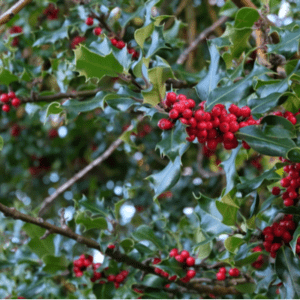 known for its glossy green leaves and bright red berries. These lovely plants grow at a slower to medium rate and can reach heights between 40 – 50 feet with a width of between 18 – 40 feet when fully mature. There are about 480 deciduous and evergreen species within this genus, including trees, shrubs, and climbing lianas. They grow well in moist, well-drained soils and prefer full sun to partial shade. If you want to enjoy the sight of bright red berries throughout winter, you will need to plant a male and female holly bush.
The benefits of planting holly trees and bushes are endless. If nature is your thing, the American holly not only provides cover for songbirds and mammals after our first PA frost settles in, but the fruit becomes food for a multitude of wildlife. It can also be used to attract our essential pollinators.
known for its glossy green leaves and bright red berries. These lovely plants grow at a slower to medium rate and can reach heights between 40 – 50 feet with a width of between 18 – 40 feet when fully mature. There are about 480 deciduous and evergreen species within this genus, including trees, shrubs, and climbing lianas. They grow well in moist, well-drained soils and prefer full sun to partial shade. If you want to enjoy the sight of bright red berries throughout winter, you will need to plant a male and female holly bush.
The benefits of planting holly trees and bushes are endless. If nature is your thing, the American holly not only provides cover for songbirds and mammals after our first PA frost settles in, but the fruit becomes food for a multitude of wildlife. It can also be used to attract our essential pollinators.
Protect Your Privacy Wall & Other Trees and Shrubs With Showcase Lawn Works
Now that you know which are the top evergreen trees for creating privacy walls in the Eastern PA area, count on the professionals at Showcase Lawn Works for all your tree and shrub care needs. Our tree and shrub care program offers six different applications spaced out every four to six weeks. It consists of the fertilization needed to help your trees and shrubs grow and insect and disease control protection. In addition, we also offer deep root fertilization, dormant oil applications, and winter burn treatments. Give us a call or contact us online to learn more. Our number is 717-354-3226. Like what you are reading? Get more tips on all things lawn care, tree and shrub care, and pest control by following our blog. Then check us out on Facebook. Request A Quote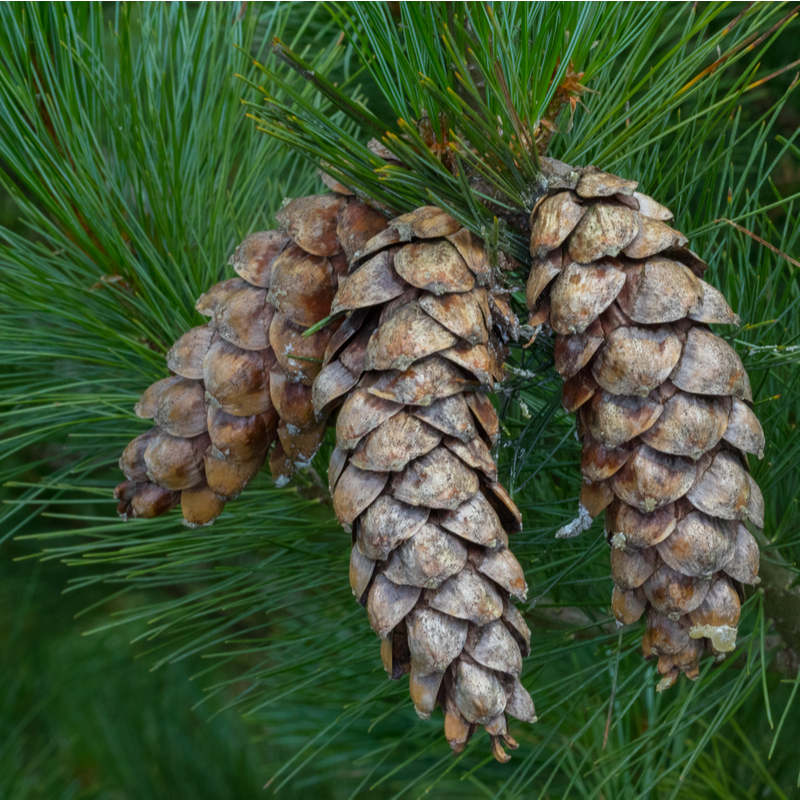
Liven Up Your PA Landscape With the Added Protection of Mulch
Now is the perfect time to spruce up your South Central PA landscape. The warmer weather is here, but there is still plenty of time to enjoy the rest of the season. The addition of mulch is a quick and easy way to brighten up any landscape, and it has a multitude of advantages for both your plants and gardens. Before we dive into what these advantages are, let's first explain what mulch is and what it is made of.Type of Mulch
Mulch is a protective layer of various materials, either organic or inorganic, spread over your soil, or around a plant or tree. Two common types of mulch used here in PA are wood, also known as bark mulch, and decorative stone mulch, also known as rock mulch. Wood is organic. Therefore, it will break down over time and deposit nutrients back into the soil. Rock mulch is not organic and will not break down in your soil, however, it won't need to be replaced as often. Here at Showcase Lawn Works, we use mulch made from organic materials such as manure, leaves, and other compostable materials. Our mulch is created so that its elements break down into your soil, doubling as a fertilizer.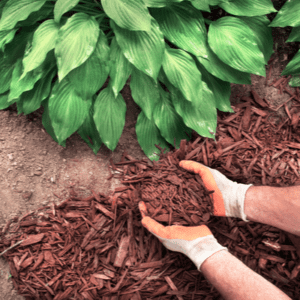
Benefits of Using Mulch
As we mentioned above, mulch provides a multitude of benefits. Some of those include:Soil Enrichment and Increased Moisture Retention
The elements that make up our organic mulch break down into our soil over time, allowing your soil to soak them up and act as additional fertilizer. Switching to mulch will also enable your gardens to be watered less. During our hot South Central PA summers, your plants and garden are susceptible to water loss. A layer of mulch will help shade them and slow down the evaporation process. Imagine your plants and garden continuing to prosper, yet you end up watering less! Add a layer of mulch around your trees and shrubs as well, and keep them cool and moist all summer long.Stronger Roots
By adding in moisture retention, mulch allows your plant's root system to grow deeper and stronger. When the moisture is given more time to penetrate the soil, it goes deeper and picks up nutrients along the way. When the nutrient-rich water hits the roots, it results in vigorous, healthy growth.Protection from Extreme Weather
In South Central PA, we can have all four seasons in one day. It is not unheard of to have your heat on in the morning and air conditioning unit on later in the day. Extreme weather conditions such as rain, wind, snow, and direct sunlight can cause soil erosion and multiple issues. Using mulch minimizes the threat of erosion during harsh weather conditions and prevents the loss of essential nutrients through runoff. In the winter, it acts as a blanket and in the summer as an insulator keeping it cool. A layer of mulch around your trees and shrubs, your garden, and around plants will help keep them protected and prepared to thrive all season long.Weed Prevention
Weeds are lawn and garden invaders stealing vital nutrients from your plants and grass. Mulch acts as a barrier preventing weeds from receiving sunlight, oxygen, and water. This will prevent them from sprouting and smother those that do. Not only will your garden look better without unwanted growth, but you will soon find you are spending less time weeding each week.Enhances Curb Appeal
There are many different colors of mulch. You can add the same or different colors around gardens, trees, and shrubs and accentuate specific areas of your landscape. Adding mulch not only adds a pop of color to your property, but with all the protection and health it adds to your plants and garden, your landscape will look better overall.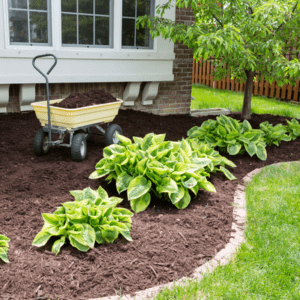
Give Your South Central PA Landscape The Boost It Needs With Mulch
Showcase Lawn Works is the solution for all your landscaping needs, including adding mulch to your property. Our mulching service is the perfect landscape pick-me-up for any home or business owner. Our organic mulch will help protect and enhance the growth of your grass, plants, garden, trees, and shrubs. We also offer other landscaping needs, including landscaping design. We want to help you turn your outdoor property into your dream escape. Learn more by visiting our website's Landscaping page, calling us at 717-354-3226, or contacting us here today. For more ideas, tips, and advice regarding lawn care and landscaping, check out our other blog articles. To get to know us more personally, follow us on Facebook and see what we're all about. Request A Quote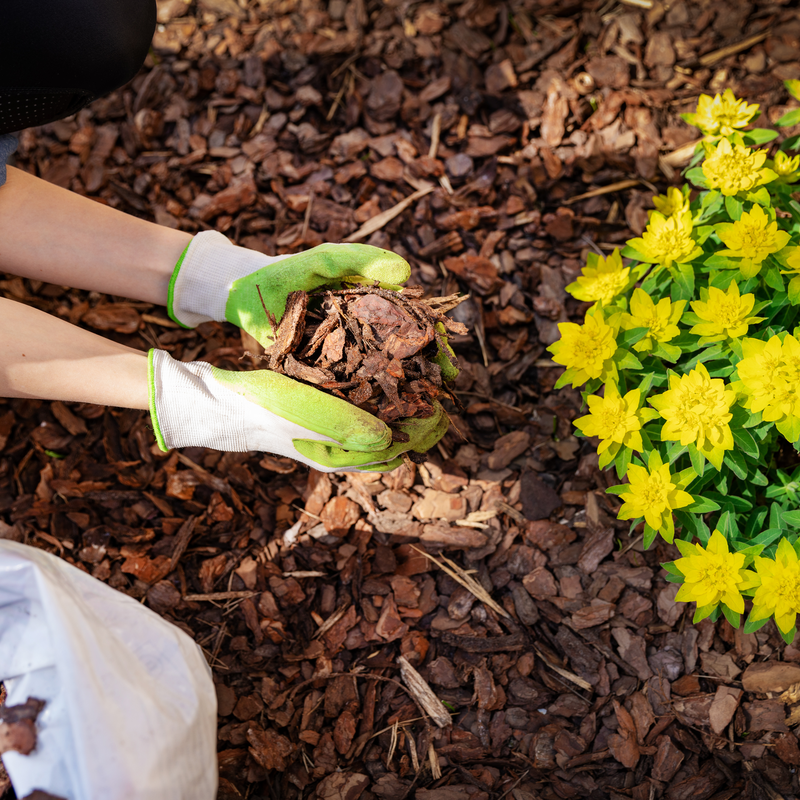
You Can Help Prevent Crabgrass With a Healthy Lawn
Weeds! Every home or business owner's worst nightmare! Like a red spot on a white carpet, they stand out, screaming to us. They stick out like a sore thumb and make us cringe every time they poke their ugly heads into our plush green lawn. Here in Pennsylvania, with our cold winters and hot, humid summers, we have our fair share. Some of the most common include:- Dandelions
- Wild Violets
- Clover
- Nutsedge
- Oxalis
- Black Medic
- Plantain
- Henbit
- Shepherd’s Purse
- Groundsel
- Common Chickweed
- Crabgrass
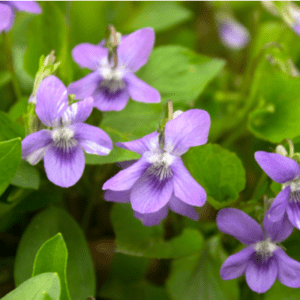 One, in particular, that taunts us year after year is unappealing crabgrass. Even in the most optimal growing conditions, crabgrass can get out of control.
One, in particular, that taunts us year after year is unappealing crabgrass. Even in the most optimal growing conditions, crabgrass can get out of control.
When Does Crabgrass Emerge In Pennsylvania?
Here in eastern Pennsylvania, crabgrass begins to emerge with spring. Seeds start to germinate when your soil has reached a balmy temperature of at least 55 to 60 degrees for a whole full week. While our seasons vary year to year, pending what mood mother nature is in, this year, it has come early, and for most of us, crabgrass has already begun.Why is Crabgrass Such a Nuisance?
Crabgrass is a rapid grower and crowds out the good grass, taking the nutrients and sunlight your actual turfgrass needs. It grows close to the ground, and its stems extend out like a crab. Not only does this make it unappealing, but it is also an opportunistic plant and will take up space anywhere it can. You have probably seen crabgrass growing in cracks along your sidewalk, driveway, and anywhere there is space. While it is annual and dies every winter, during the time it is alive, it germinates and spreads around a vasts number of seeds ensuring it will bounce back when spring arrives again.Can I Prevent Crabgrass From Taking Over My Lawn?
Crabgrass is often found in thin lawns or patches of your turf that insects or diseases may have damaged. Most healthy lawns can resist severe crabgrass infestations. Any open space can be quickly monopolized by crabgrass in late summer when the sun is at full impact. Therefore the best way to prevent crabgrass from taking over your lawn is through proper maintenance and care. Investing in a lawn care maintenance plan that includes fertilization, weed, and insect control can go a long way toward protecting your lawn from various problems, including a crabgrass infestation.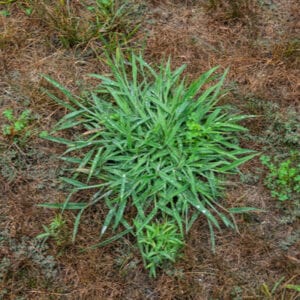
Protect and Prevent Crabgrass With Showcase Lawn Works Lawn Care Program
At Showcase Lawn Works, we provide a comprehensive, six-step lawn care program with crabgrass control built right into it. Our six treatments spaced out every four to six weeks begin in early spring and last through late summer. On visit one, we include pre-emergent crabgrass control to help prevent this vial weed and other broadleaf weeds from germinating. On visit two in we include crabgrass control herbicide to counteract any crabgrass that has already started growing. Our highly effective lawn care program also includes a balanced slow-release fertilizer to help your turf remain nourished and a strong spot weed control to target those hard to eliminate weeds. With the best prevention being a well-maintained lawn, utilizing our lawn care program will give you double protection against the chance that a crabgrass infestation will take over. Contact us now by phone at 717-354-3226 or fill out our form online. For more tips and ideas on all things lawn care or landscaping, check out our other blog articles. Get to know us more intimately by following us on Facebook. Request A Quote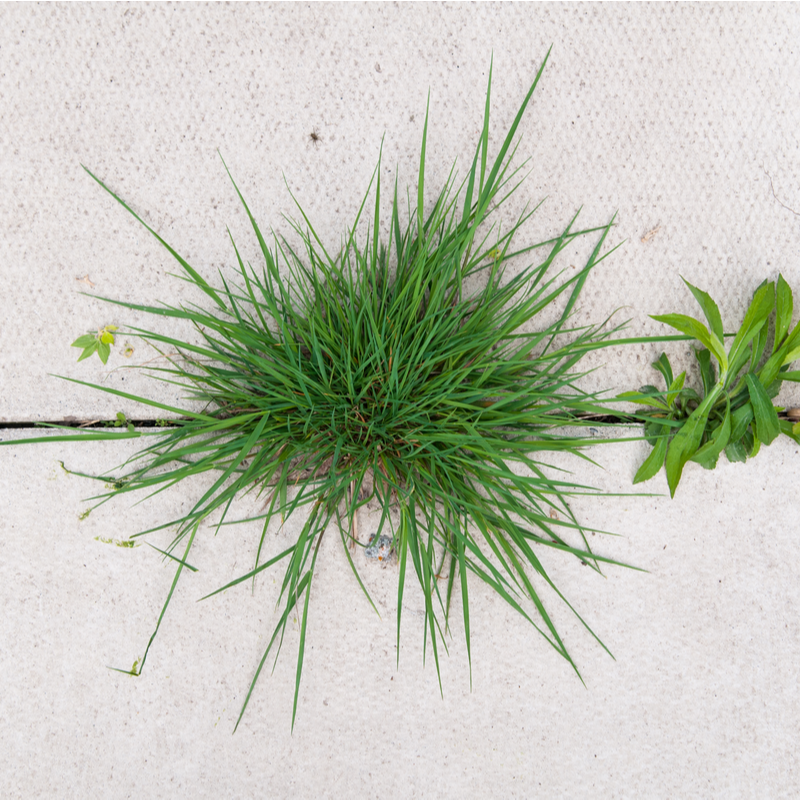
Prepare Your PA Lawn for Spring With a Lawn Care Program
The weather is starting to get a bit warmer, trees have begun budding, kids are playing more outside, and migrating birds have become flying in from the south. This means it is the perfect time to start thinking about lawn care. At Showcase Lawn Works, we offer a variety of services that can help you get started. We've listed some of them below along with various tips on how to prepare your Pennsylvania lawn for the upcoming summer.Debris Clean-Up
Our Pennsylvania winters can be harsh on our lawns, and often we have no idea what our grass looks like until all of that snow melts. Once it does, we often find fallen debris such as branches, twigs, and even trash that the wind has blown in. The first step toward preparing your lawn for spring is cleaning up whatever mess old man winter has decided to leave behind. Showcase Lawn Works can help. We offer a seasonal cleanup service to help rid your yard of the various leaves, sticks, grass clippings, and other accumulated debris.Thatch Raking
Because dead organic material such as grass clippings can cause mold, mildew, and fungi to thrive, you may want to try raking your lawn. While it's best to use a thatch rake, a normal rake will do. Raking your yard of the excess thatch will allow the much-needed sunlight, water, and oxygen to permeate the roots.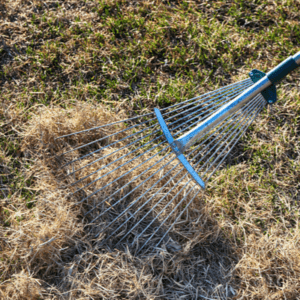
Soil Testing
It's a good idea at this time to test your soil. Lawn care is a science, and testing your soil will help to determine its current nutrient status. Besides indicating any nutrient deficiencies, a soil test can also provide information on soil acidity, the percentage of organic matter in your soil, and your soil’s texture. Your grass's growth depends on your soil's pH level. What is a pH level, you might ask? It is the measurement of how acidic your soil is. This is important because a soil's pH level determines how well your grass will receive nutrients. Most types of grasses prefer neutral soil with a pH balance between 6.2 and 7.2. When your soil's acidity or alkaline levels are out of balance, it makes it difficult for your grass to utilize the nutrients. Here in southeastern Pennsylvania, our soil tends to lean towards the acidic side. At Showcase Lawn Works, we start with a soil test to determine the amount of lime and the number of applications needed to balance your pH levels properly.Time to Get Your LawnMower in Order
While you may already have your lawnmower out, it's important to properly maintain it and make sure it's in working order before summer hits. You can do this by walking through the following essential steps:- Change the spark plugs.
- Change or have the oil changed by a professional.
- Clean or replace the air filter depending on what type of filter your lawn mower uses. Check the manual to be sure.
- Sharpen the blade. A sharp blade will cut smoothly and allow the grass to grow healthy. A dull blade tends to rip apart your grass blades and create ugly brown tips.
- Clean all parts of the mower, removing any leftover debris from the previous season.

The Importance of a Lawn Fertilization and Weed Control Program
Lastly, invest in lawn fertilization and weed control program. Like all living things, grass needs food to stay alive. A healthy and active lawn uses a great deal of energy. Over time, soil loses many of the active nutrients your grass needs to survive. Grass that is nutrient deficient will be more susceptible to disease and insects. Adding additional fertilizer will help to replenish and restore the nutrients that were lost. This will promote strength and increased growth. Utilizing weed control applied in the right amounts at the right time will help control weeds without harming your grass. At Showcase Lawn Works, our lawn care program offers an organic-based fertilizer to help promote strong and rapid root growth. It also contains broadleaf weed control to help control bothersome weeds such as dandelions, clover, and nutsedge. Learn more about our lawn care program or contact us to request an estimate now. Don't wait. Now is the perfect time to start analyzing your soil and get started on a fertilization and weed control maintenance schedule. Other lawn care services we provide include lime application, aeration, grub control, and pest control. Check out some of our past blog articles for more tips and ideas, and follow us on Facebook for all of our latest news. Request A Quote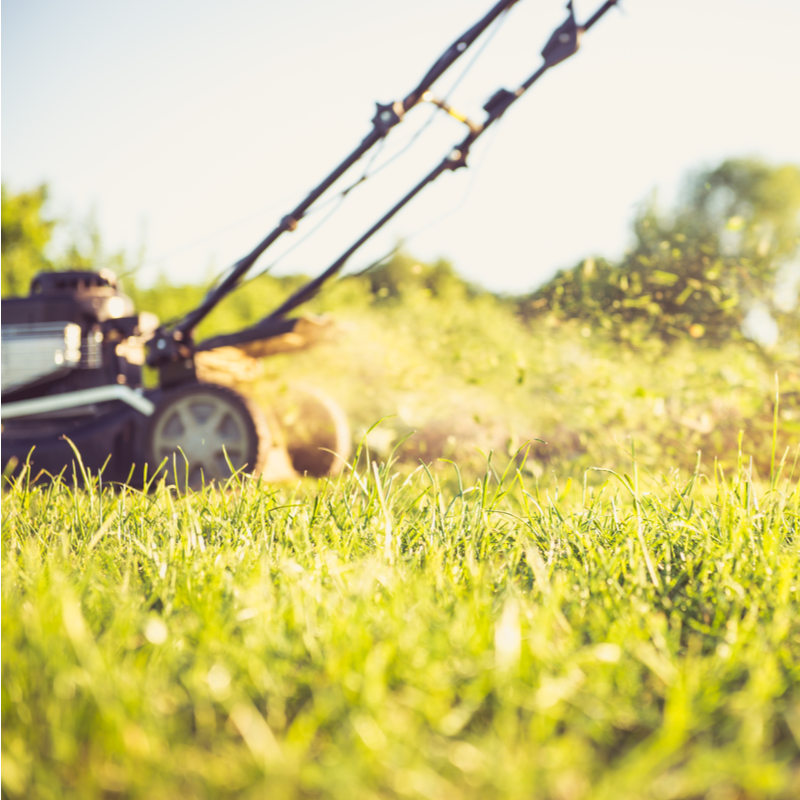
Set Your Lawn Up For Success This Spring
All of us are spending far more time at home with the on-going pandemic. Maybe yard work is something you've neglected or meant to learn more about but never had the time. We've compiled a list of lawn care tips to try this spring, so your yard is the green oasis you've always dreamed of.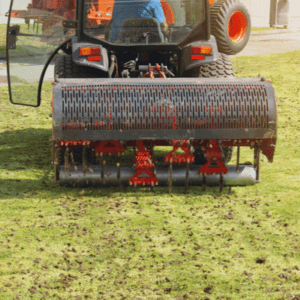
Lawn Care Ideas
Aeration
Over time, the soil becomes compacted from thatch build-up, foot traffic, and other environmental factors. Aerating your lawn once a year keeps the soil loose enough that air, water, light, and nutrients can penetrate the soil and nourish the grass's roots. Aeration, or core aeration, is the process of removing small plugs of soil from your lawn using a specialized machine. These cores are left on the surface and will break down naturally like compost. The series of small spaces give your grass room to breathe, making it stronger and more resilient. The ideal time to perform core aeration is late summer or early fall.Thicken Turfgrass
If you notice thinning or bare patches of grass, you don't necessarily have to start over from scratch with new sod. Hydroseeding and overseeding are both options that will address problem areas of your lawn. Hydroseeding involves laying down seeds within a specialized mixture, or "slurry," that nourishes the seeds. Overseeding is exactly what it sounds like: turfgrass seed is scattered over the surface of the soil. Both are good for thickening your lawn. However, if you plan to aerate, overseeding is often done in conjuncture with this service. Overseeding nicely compliments aeration since the grass seeds can easily pill in the gaps left behind.Set Your Mower To The Proper Height
While this may seem like a common-sense part of any lawn care program, many people don't realize just how important mowing can be. Mowing grass too short or too long can create problems down the road. Mowing too close to the earth can allow weeds to sprout. Weeds thrive in direct sunlight, so keeping your grass at the proper height casts enough shade that weeds can't grow. Conversely, longer grass can trap too much moisture - the ideal environment that molds, mildew, and fungi thrive in.Test The Soil
Lawns need three things when it comes to fertilizer: nitrogen, phosphorus, and potassium. When purchasing fertilizer, you will see these things displayed in a series of three numbers. For example, 2-3-5. Nitrogen helps plant leaves and stems grow strong. Phosphorus nourishes roots, flowers, and fruits. Potassium helps plants tolerate environmental stressors like droughts. Having a soil test performed will help you learn what your plants crave and, more importantly, if the soil will be receptive to it. If your soil pH level leans to the spectrum's acidic end, it won't be receptive to fertilizer. In other words, you would be wasting money applying fertilizer that the grass won't be able to use. If your soil needs a balance, don't worry. A simple lime application will correct the pH level and, in turn, make it, so plants utilize any nutrients you give them.
Get Spring Lawn Care Done Right - Call Showcase Lawn Works
Make this spring the season you finally get the yard of your dreams. From fertilizer to weed control, the experts at Showcase Lawn Works will set your yard up for success. Get a head start planning your dream backyard today! Call 717-354-3226 or contact us online. For more lawn care inspiration, check out our blog, and don’t forget to follow us on Facebook! Request A Quote
Don't Allow These Pests to Destroy Your Precious Trees
Do you have a favorite tree from your childhood? One you used to climb or built a treehouse in? Trees are part of our everyday life. They create oxygen, provide shade, create homes and shelter for wildlife, beautify our landscapes, and filter out air pollution. Here in Pennsylvania, they are the backdrop for our homes. But like our lawns, there are dangerous insects upon us that can wreak havoc and cause damage to our beloved lawn statues. Some species are native, while others are non-native. Let's take a look at some of the insects that have caused the most damage to our PA trees in recent years.
Emerald Ash Borer
The Emerald Ash Borer (EAB) is a half-inch long metallic green beetle first identified in the Commonwealth state in 2007. This little creature looks exotic but packs a mean punch. While the adult beetles cause little damage, the young larvae feed on the critical parts of the tree, prohibiting the tree’s ability to transport water and nutrients. Most ash trees will die within two to three years after becoming infected.Signs and symptoms of an Emerald Ash Borer infestation include:
-
Canopy thinning and upper crown dieback
-
Epicormic sprouting
-
Bark splits
-
Bark flaking
-
Because woodpeckers will eat these beetles, tissue damage can occur
-
D-shaped exit holes in the bark
-
S-shaped larval feeding galleries just below the bark
Ways Pennsylvania Homeowners Can Prevent and Stop Emerald Ash Borer From Taking Over
There are specific insecticides that are available to treat affected ash trees. While some are marketed for homeowners, the most effective option is to hire a professional landscape company such as Showcase Lawn Works. You can help prevent EAB by only purchasing and using local firewood. Invasive insects such as EAB can sit on firewood for long periods giving them free rein to infest new locations when moved.
Gypsy Moth
The Gypsy Moth is responsible for killing millions of oak and other tree species including but not limited to aspen, birch, cedar, poplar, and willow throughout Pennsylvania. It is a caterpillar with a voracious appetite that can strip a tree of its full foliage. This tree defoliation leaves the tree vulnerable to diseases and other pests and can eventually kill the tree. Gypsy moths are easy to identify because of their distinct coloring.Signs of a gypsy moth infestation include:
- Teardrop-shaped egg masses tan to yellowish in color with a hairy appearance on tree trunks, outdoor furniture, and a home's siding
- Trees suffering from light leaf damage to complete defoliation
How You Can Help Prevent Gypsy Moths From Taking Over
The best way to prevent a gypsy moth infestation is through adequately maintaining your trees and shrubs. Proper watering, fertilization, and pruning can help keep your trees and shrubs healthy enough to withstand an attack if one occurs. At Showcase Lawn Works, we offer a tree and shrub program that provides your beloved ornamentals with the appropriate amounts of nutrients, as well as the right amount of insect control. If you do discover egg masses in your yard or on your trees, destroy them immediately by drowning them in kerosene or burning them. Dormant oil applications utilized in the fall and early spring can also help.Thousand Canker Disease
It may sound like the beginning of a salad dressing, but Thousand Canker Disease is a fungus carried by the Walnut Twig Beetle. They will tunnel beneath the bark of black walnut trees, causing small cankers to form. Once there is an overabundance of cankers, these abscesses disrupt water and nutrients' movement throughout the tree. The lack of these necessities causes dieback of branches and eventually kills the tree. Early symptoms include yellowing of the leaves and thinning of the upper crown.What Can You Do About This Dreadful Disease?
Like with most other diseases, not transporting wood can help. Only buy or use local wood. Help protect any black walnut trees on your property through proper maintenance and care. A tree and shrub care program that includes fertilization and insect control can help give your trees the strength and durability needed to ward off disease and insect infestation.For all Your Tree and Shrub Care Needs, Contact the Professionals at Showcase Lawn Works
Showcase Lawn Works knows that your trees, shrubs, and hedges are essential investments to your landscape. That's why we offer a tree and shrub care program to help increase your plants' strength as well as protect them from fungi and disease-carrying pests. We also offer deep root fertilization, dormant oil applications, and pruning. For more information about any of these services and how you can help increase the life of your trees and plants, give Showcase Lawn Works a call at 717-354-3226 or contact us here. For more tips and ideas, check out our other blog posts and get to know us more intimately by following us on Facebook. Request A Quote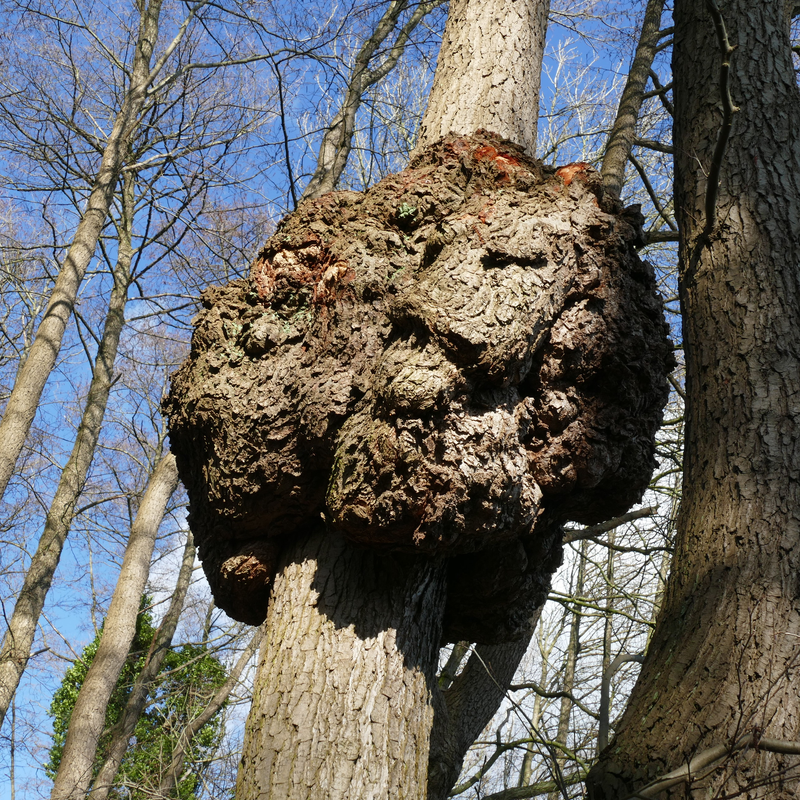
Are Fleas Still Active During The Winter?
Baby, it's cold outside! It's January here in PA, and that means frost on our windshields, dry, chapped hands, and possibly even snow in our driveways. One thing we don't think of this time of year is those irritating fleas. But perhaps we should. Some of those pesky critters may have found their way into your home through the fur of your cuddly best friend. Fleas prefer the warm temperatures, and once inside, the warmth of your home provides them a cozy place to live, survive, and breed. Fleas multiply very quickly. The female flea will drop from the host and immediately lay between 40 - 50 eggs per day. They can lay eggs in your carpet, beds, sofas, and various areas of your house where your pet spends most of their time. After the eggs hatch, they feed on digested blood left behind by adult fleas. In about one or two weeks, the larvae spin a cocoon. This cocoon can last up to a year, waiting for the ideal environment in which to thrive.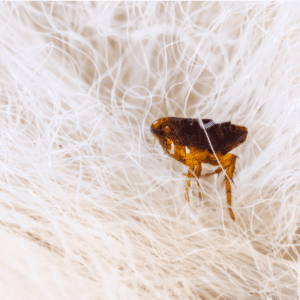
Why Are Fleas Such a Bother?
Flea infestations can cause your pet discomfort, scratching, and infections. They can also be harmful to humans.Tapeworms
These nasty creatures make themselves at home in the intestines of dogs, cats, and humans. Pets obtain tapeworms by swallowing infected fleas. Though it is rare, toddlers may become infected by eating an infected flea as well. Thankfully, the tapeworm is treated with medication.Mycoplasma haemofelis
Mycoplasma haemofelis is a parasitic, bacterial disease that is transmitted from fleas to cats. It has been found in rare cases in humans with compromised immune systems. Treatment typically includes the use of antibiotics.Murine Typhus
Murine typhus is rare, but if there is anything we have learned in 2020, it's that things we never thought possible could occur. Rats are the leading carrier of this disease, but cats can also come in contact with infected fleas and carry them onto humans. Humans then get infected through flea bites. Symptoms include headache, fever, nausea, body aches, and a rash on arms and legs. Treatment includes antibiotics, but it's crucial to catch right away as a delay in treatment can lead to a more serious illness.How Can You Prevent a Flea Infestation?
If you are a pet owner, you can take the necessary steps to protect your home from these unpleasant creatures and minimize your risk of infection. While we highly recommend calling in professionals for flea control, there are a few ways in which you can help to prevent an infestation. They are:- Clean and vacuum the area(s) where your pet spends most of its time including, where it eats, periods of sleep, and hangs out
- Wash everything your pet uses, sleeps, and rests on. This includes beds, blankets, sheets, and toys
- Inspect and treat your pets. Check with your veterinarian on the proper treatment for your pet. Routinely check your pet’s fur for signs of fleas to help prevent future infestations
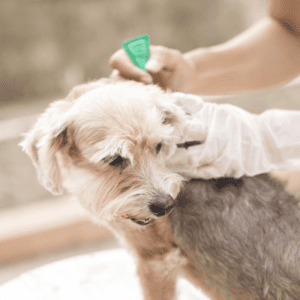
Protect Your Home Year-Round
At Showcase Lawn Works, we take proactive measures to ensure fleas are never a problem for you. We offer a highly effective barrier spray that kills fleas and ticks on contact. Call 717-354-3226 or contact us online to learn more. For more tips and ideas, check out our other blog postings. On social media? Like us on Facebook and get all our latest deals and other info. Request A Quote